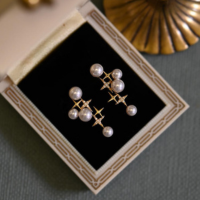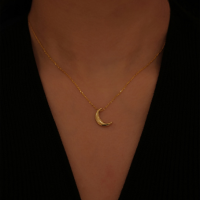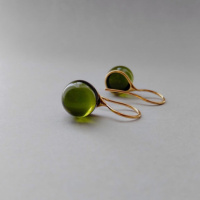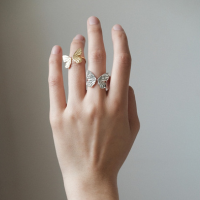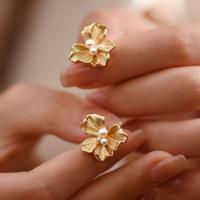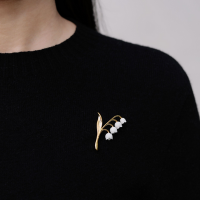
What Jewelry Doesn't Tarnish
Check out our personalized jewelry collections! (kids drawing jewelry, coin jewelry, wire jewelry, fingerprint jewelry, handwriting jewelry, and more)
When we're picking out jewelry, we want pieces that stay beautiful over time. Many metals can lose their shine or color, yet some remain unchanged. Jewelry made from materials like stainless steel, platinum, and high-quality gold often doesn't tarnish. These are choices that keep their charm with little effort.
We should think about what gemstones or materials match our lifestyle. Busy lifestyles might demand more durable pieces that can handle daily wear without losing their luster. Some jewelry also has protective coatings that enhance their resistance to tarnish, keeping them bright and lovely over time.
It's also essential to know how to care for our jewelry properly. Maintenance can make a big difference, like remembering to clean pieces regularly and storing them safely. Learning these simple steps can help us preserve the beauty of our cherished items for years.
Key Takeaways
- Choose jewelry materials like platinum and stainless steel to avoid tarnish.
- Practical care and protection help jewelry maintain its shine.
- Match jewelry to your lifestyle for lasting beauty.
Understanding Jewelry Materials
When choosing jewelry, it’s vital to know which metals resist tarnishing. Some materials maintain their brilliance with minimal care, offering both beauty and durability. Let's explore these options.
Gold and Gold Plating
Gold is highly resistant to tarnish and corrosion. Pure gold, or 24K gold, never tarnishes due to its lack of other metal elements. However, it's soft and often mixed with stronger metals in jewelry making.
Gold plating involves covering a base metal with a thin layer of gold. While this offers a gold-like appearance, it can wear off over time, exposing the metal underneath. For jewelry that stays lustrous, solid gold is a better investment than plated options.
Sterling Silver
Sterling silver is an alloy, typically containing 92.5% silver and 7.5% other metals, like copper. It's loved for its bright shine and affordability.
Sterling silver can tarnish when exposed to air and moisture. Regular cleaning and proper storage help keep it shiny. It's a great choice if you enjoy the classic look of silver and don't mind a little upkeep to maintain its glow.
Stainless Steel
Stainless steel is incredibly durable and doesn't tarnish easily. It's resistant to rust, corrosion, and water damage, making it ideal for everyday wear, even in harsh conditions.
This metal's strength and shine are maintained with simple care. With its affordable price and sleek look, stainless steel is a practical and stylish option for jewelry enthusiasts.
Platinum
Platinum is a premium metal known for its natural white shine and resistance to tarnish. It’s both strong and hypoallergenic, making it perfect for sensitive skin.
Though more expensive, platinum won’t fade or change color over time. This makes it a lasting choice for special pieces like engagement rings or heirloom jewelry, where enduring quality is paramount.
Titanium
Titanium is celebrated for its incredible strength and lightweight feel. It's also hypoallergenic, appealing to those with metal sensitivities.
While titanium is not entirely tarnish-proof, it's highly resistant to corrosion and wear. It maintains its appearance with little maintenance, making it a favorite for modern, durable jewelry designs. Its versatility and resilience make titanium a stand-out choice.
Opting for Durable Gemstones
When considering gemstones that resist tarnishing, diamonds, sapphires, and rubies stand out. These stones not only maintain their beauty over time but also offer unique qualities that enhance various jewelry pieces.
Diamonds
We all know diamonds are incredibly hard, making them perfect for everyday wear. Rated at 10 on the Mohs scale, they are the hardest natural material, ideal for rings and bracelets. Their brilliance and clarity are unmatched, and they resist scratches and chips.
Cleaning Tip: Diamonds are easy to clean. Just soak them in a gentle dish soap solution and brush with a soft toothbrush.
Color: While traditional diamonds are clear, colored options like blue, yellow, and pink add a unique style to any piece.
Their durability and wide variety make diamonds a timeless choice for both classic and modern jewelry.
Sapphires
Sapphires, often recognized in deep blue, come in various colors like pink, yellow, and green. With a hardness of 9 on the Mohs scale, they’re incredibly sturdy but still need some care to avoid chips.
Symbolism: Many believe sapphires represent wisdom and nobility.
Though mostly famous in engagement rings, we can find sapphires in everything from necklaces to earrings.
Tips for Everyday Care: Simply wipe them with a soft cloth after wearing to maintain their shimmer. If you love a touch of color, sapphires offer vibrant options that ensure longevity and beauty.
Rubies
Rubies boast a rich red hue, often symbolizing passion and love. Scoring a 9 on the Mohs scale makes them ideal for long-lasting jewelry that’s truly eye-catching.
Historically, rubies were popular among royalty and have a timeless appeal today. Known as the "King of Gemstones," their color ranges from pinkish-red to deep, purplish-red.
Rubies pair exceptionally well with both silver and gold settings. Care Tip: Clean them with lukewarm water and mild soap, using a soft brush to preserve their luxurious shine.
In choosing rubies, we embrace a gem that remains as stunning and robust as our most treasured memories.
Protective Coatings and Finishes
Jewelry can maintain its shine with special coatings. These treatments help protect the metal and keep it looking new. Among the most effective are Rhodium Plating and E-Coating.
Rhodium Plating
Rhodium plating is popular for jewelry. It gives pieces a bright, reflective look and protects against scratches and tarnish. Rhodium is a rare metal known for its high shine and resistance to corrosion.
When jewelry, especially silver and white gold, gets rhodium plated, it gets a beautiful white sheen. This finish also prevents the item from easily scratching or losing its color. Rhodium offers a protective layer against everyday wear. However, it's important to know that the plating can wear off over time, especially on rings. Thus, it might require occasional re-plating to maintain the jewelry's appearance.
With rhodium plating, our jewelry stays stunning and durable while retaining value and appeal, making it a favorite for rings, necklaces, and more.
E-Coating
E-Coating, or electrophoretic coating, is another way to protect jewelry. This technique involves applying a thin, clear coat to metals. It acts like a shield, preventing jewelry from tarnishing. E-Coating is especially useful for costume jewelry, which can lose its shine more easily than precious metals.
During the process, jewelry pieces get submerged in a special solution and an electric charge helps the coating stick evenly. It dries quickly and becomes a hard, transparent layer. E-Coating is less reflective than rhodium but still offers great protection from wear and tear. This makes it an attractive option for everyday jewelry. It also helps maintain color and gloss for longer periods, eliminating frequent polishing.
Our choice for E-Coating ensures our jewelry remains vibrant and glossy, perfect for pieces worn regularly.
Maintenance and Care Tips
Let’s keep our jewelry looking fabulous! Regular care is key. We should avoid exposing our pieces to harsh chemicals. Wearing perfume or lotion? Let it dry before putting on our jewelry. It's a small step but makes a big difference.
Store jewelry properly. Use soft cloth bags or jewelry boxes with compartments. This helps prevent scratches and tangling. For silver jewelry, adding anti-tarnish strips to storage areas can be helpful.
Cleaning is important. We can use warm water and a mild soap to clean most pieces. Gently scrub with a soft toothbrush. Rinse well and pat dry with a soft cloth. Always make sure everything is dry before storing.
For extra care, we might consider professional cleaning. Jewelry shops often offer specialized services. This ensures our pieces remain in top shape and sparkle brightly. Simple routines like these help keep our beloved jewelry looking like new!
Choosing the Right Jewelry for Lifestyle
When it comes to jewelry, matching our lifestyle is essential. We want pieces that not only look great but also fit our activities.
Active Lifestyles: For those who are always on the move, stainless steel and titanium are perfect. They're durable and resist damage. These materials are also lightweight, making them comfortable for any workout or adventure.
Formal Settings: Those of us who spend a lot of time in formal settings might prefer timeless options like gold or platinum. Both add a touch of elegance. Gold offers warmth and tradition, while platinum is subtle yet luxurious.
For artistic and creative minds, silver and custom-made designs are ideal. Silver offers a classic look, while custom designs can reflect personal style.
Here's a quick guide to help:
| Lifestyle | Recommended Material | Key Features |
|---|---|---|
| Active | Stainless Steel, Titanium | Durable, Lightweight |
| Formal | Gold, Platinum | Elegant, Luxurious |
| Artistic | Silver, Custom Designs | Classic, Unique |
It's important to consider any allergies too. Nickel-free options are available for sensitive skin.
Where to Find Quality Pieces
When we're on the hunt for quality jewelry, shopping smart is key. Reputable jewelers are great places to start. They often offer anti-tarnish pieces. Look for stores with certifications or good reviews.
Online marketplaces like Etsy offer unique, handmade options. We can find sellers who use anti-tarnish materials. Always check for detailed descriptions and customer feedback.
Luxury brands like Cartier or Tiffany & Co. provide pieces that stand the test of time. These brands use high-quality metals that resist tarnishing. Investing in these can be worthwhile.
Local artisans often create distinctive, handcrafted pieces. This way, we're supporting small businesses and often getting unique jewelry. Plus, we can ask them directly about the materials they use.
Finally, duty-free shops in airports can have some bargains. Their selections often include quality brands at reduced prices. This can be a smart option for us when traveling.
Frequently Asked Questions
In this section, we'll answer common questions about choosing jewelry that resists tarnishing. We'll explore different metals and materials, options for everyday wear, and where to shop for high-quality pieces.
How to find affordable gold jewelry that remains untarnished?
When looking for gold jewelry, consider pieces that are plated with a thick layer of gold or use gold alloys like 18k or 14k. These tend to resist tarnishing better than lower karat options. Check for reputable jewelers offering lifetime warranties or exchanges to ensure durability.
What are the best metals for jewelry to ensure they don't tarnish over time?
Metals like platinum and stainless steel are renowned for their tarnish resistance. Platinum is hypoallergenic and durable, while stainless steel offers strength and affordability. Both materials maintain their shine and require minimal maintenance, making them excellent choices for long-lasting jewelry.
Can you recommend types of jewelry that maintain their shine even after being exposed to water?
Jewelry made from titanium or ceramic is water-resistant and holds up well against moisture. Titanium is lightweight and strong, while ceramic is scratch-resistant and stylish. These materials retain their luster even after regular contact with water, ideal for active lifestyles.
Which materials are ideal for everyday jewelry to prevent tarnishing?
For everyday wear, we recommend titanium, platinum, or high-quality stainless steel. These materials are robust, lightweight, and resistant to everyday factors that cause tarnishing. They're perfect for pieces like rings and bracelets that see frequent wear.
Where can I purchase high-quality silver jewelry that won't easily tarnish?
Sterling silver jewelry with rhodium plating offers great tarnish resistance. Look for online retailers specializing in silver pieces with protective coatings. Local jewelers may also provide handcrafted, high-quality options with warranties against tarnishing.
What jewelry can I confidently wear in the shower without worrying about tarnishing?
Materials like titanium, stainless steel, and platinum can handle shower use without tarnishing. These durable materials allow you to enjoy your jewelry worry-free, even when exposed to water and moisture regularly. Avoid wearing pieces made with softer metals or sensitive materials.

